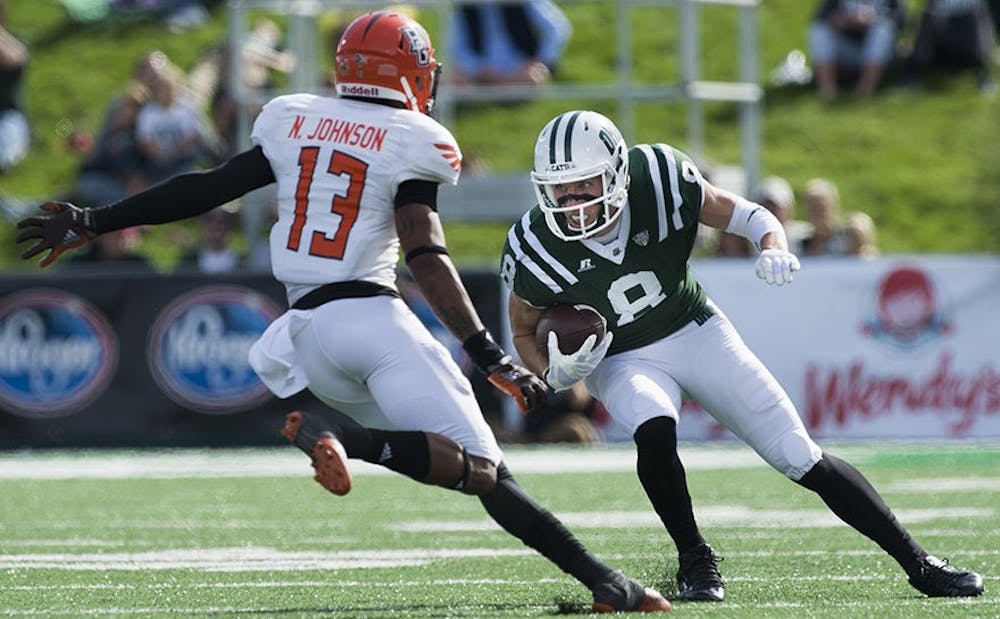The Bobcats are awaiting their postseason fate after clinching bowl eligibility.
Although memory loss isn’t very common for college kids in their 20s, Ohio might be experiencing some after wrapping up its regular season.
The trigger the Bobcats needed to suppress memories from a pair of bad Novembers might have come from one half of play last Tuesday against Miami. After losing to Northern Illinois in week 11 and facing a 21-point halftime deficit to the RedHawks, Ohio scored 24 unanswered points to defeat its rival and avoid finishing with a losing record, which would have been its first since 2008 — one of just two losing seasons during coach Frank Solich’s 10 years in Athens.
“I think a team can find itself all of a sudden giving up if you ever wanna use that term, which I never wanna use,” Solich said after the Miami game. “But there are teams that would and this team obviously refused to do that.”
The Bobcats combined to finish the previous two seasons with a 2-6 November record, but reversed the trend this year by winning two of their three November games. The only loss was decided by a touchdown to the Mid-American Conference-leading Huskies.
With its MAC Championship chances already out-of-reach, Ohio entered the final month of the regular season knowing it needed at least two victories to clinch a .500 record and become bowl-eligible. After winning against Buffalo and Miami, the Bobcats have put themselves in position to make a sixth-consecutive postseason appearance.
“There was a time there when things weren’t going very well,” Solich said. “We were beat up, we had to go through a nine-game stretch, we had a lot of things working against us, but they always came out, they practiced hard — they believed in themselves.”
Still, Ohio might have played its final down of the 2014 campaign last week when redshirt junior kicker Josiah Yazdani drilled a game-winning field goal after missing one just minutes beforehand. The Bobcats can’t do anything for now but wait to see if those November wins are enough to wedge itself into a bowl game with a 6-6 record.
“If we’re fortunate enough to be in a bowl game I know this team will prepare hard and it will prepare well and we’ll be ready to play a good football game. That’s all I know,” Solich said.
Although the Bobcats are bowl-eligible, they have the worst overall record of the six MAC teams that have clinched eligibility.
The MAC has guaranteed bowl tie-ins with five bowls: the Famous Idaho Potato Bowl (Boise, Idaho), Raycom Media Camellia Bowl (Montgomery, Alabama), Boca Raton Bowl (Boca Raton, Florida), Popeyes Bahamas Bowl (Nassau, Bahamas) and the GoDaddy Bowl (Mobile, Alabama).
If, however, the Bobcats aren’t offered a bid this coming weekend to play in any of those bowls, they could receive one of the MAC’s secondary tie-ins, including the Quick Lane Bowl in Detroit and one of a few ESPN-owned and operated bowls. One of those ESPN bowls is the Bitcoin St. Petersburg Bowl — a new sponsor of what was formerly the Beef ‘O’ Brady’s Bowl that Ohio played in last season.
The MAC also has secondary tie-ins with the San Diego County Credit Union Poinsettia Bowl when Navy isn’t bowl-eligible. The Midshipmen are bowl-eligible this year after winning last Friday.
But Ohio’s résumé might not stack up well against other teams vying for a bid. None of the teams the Bobcats defeated this season finished with a winning record and they lost on the road to their most-prolific non-conference opponents, Kentucky (5-7, 2-6 Southeastern Conference) and Marshall (11-1, 7-1 Conference USA).
Regardless, after facing a losing record to start November for the first time since its bowl streak began, the Bobcats finished with resilience and didn’t roll over after suffering mid-week blowouts the previous two seasons.
“We needed a win just to be 6-6 — no one wants to have a losing record,” freshman running back A.J. Ouellette said. “And it’s big to be 6-6 and bowl-eligible.”
@chadlindskog
cl027410@ohio.edu






